Because we were traveling with Ethan (Oliver’s service dog) on our trip to Europe this summer, we decided that we’d try to rent a camper van for our accommodations: this, we reasoned, would remove the need for nightly “are dogs okay?” negotiations with hotels, would place us out in some variation of nature (being easier for dog walks and general well-being) and, besides, who doesn’t entertain an Arlo Guthrie-fuelled dream of owning a VW microbus.
Fortunately, our friends Bill and Michelle had some experience in this regard, having rented a VW California for a 5 week trip with their daughters several years ago, so we got to know, through Bill’s eyes, something of the lay of the land, and what might be possible.
We ended up renting a camper from DRM, an established operation with several branches in Germany; the alternative was McRent, which has a broader footprint, but they didn’t have stock of the VW campers near where we wanted to start from. Here’s what it looked like on our first night of camping, on the Rhein north of Düsseldorf:
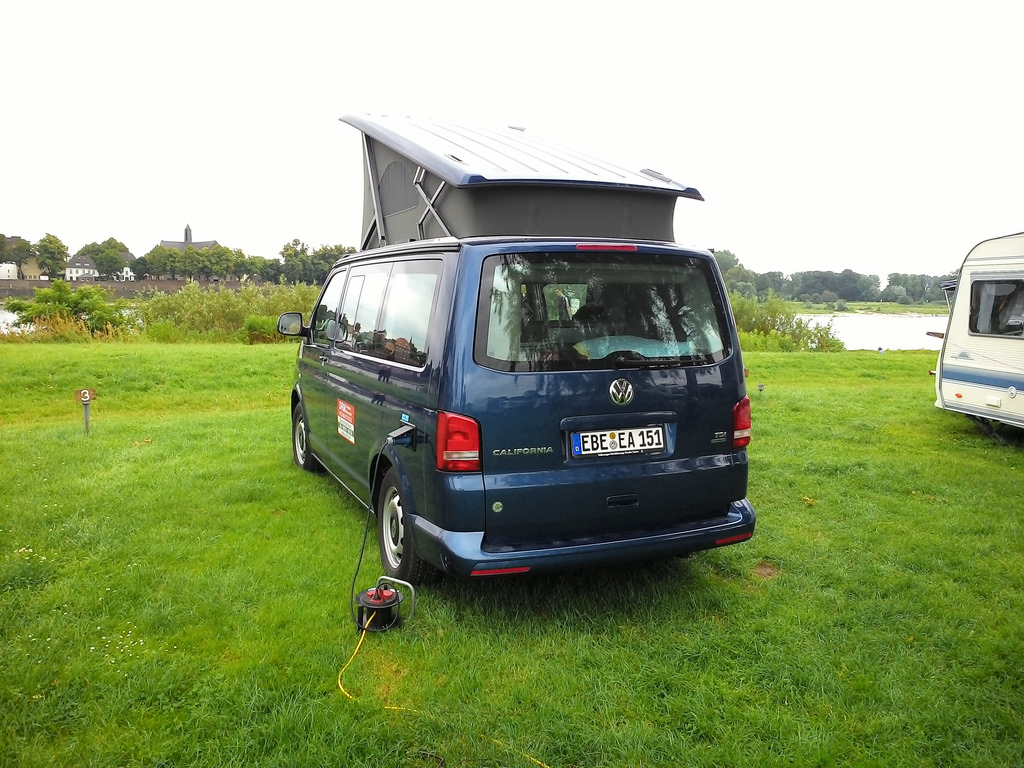
How much did it cost?
The cost for the rental broke down like this:
- The camper rental itself was 88 € a night for the first 13 nights and 116 € for the last night, for a total of 1,260 €.
- On top of that was a 110 € service fee, 30 € for 3 camping chairs, 10 € for a camping table, 55 € for a kitchen set (plates, bowls, knives, pots, etc.), and 165 € for three sets of bedding.
- The total cost, then, was 1630 €, which, at today’s exchange, is about $2300 Canadian, $164 a day.
We had to leave a 1300 € damage deposit when we picked up the van; 890 € of that were returned to us after 4 issues (some scratched in the plastic and paint and a kink in the pop-up roof) were deducted. We were careful with the van, and these issues, while clearly present during the inspection on return, came as an unexpected surprise. So the real cost, at the end of the day, was about 2000 €, or about $2900 Canadian.
Picking up the Camper
We chose the Düsseldorf station for pick up because it was nearest to our first destination of Enschede in the Netherlands. The DRM station was in the southern end of the city, so we took a cab from the airport when we arrived, which cost us about $60 and took about half an hour. When we arrived the van was waiting for us, and after some paperwork we were given a walk-through of all of its systems (pop-up roof, stove, fridge, etc.). Given that we’d just stepped off a red-eye flight from Canada, I retained only about 60% of this information and were I to go through the process again I would have arranged for an overnight in a hotel before picking up the van.
Distance and Gasoline
We drove a total of 1119 km over 14 days, from Düsseldorf up into the Netherlands, across to Utrecht, down into Belgium and back to Düsseldorf. On the map (I was dropping a digital breadcrumb via my mobile phone every minute) the trip looked like this (there are some misplaced pins because of flaky GPS: we didn’t go into Amsterdam, for example; and the map is incomplete because sometimes my phone battery was dead, my mobile data plan ran out, or we were in an area of bad mobile coverage):
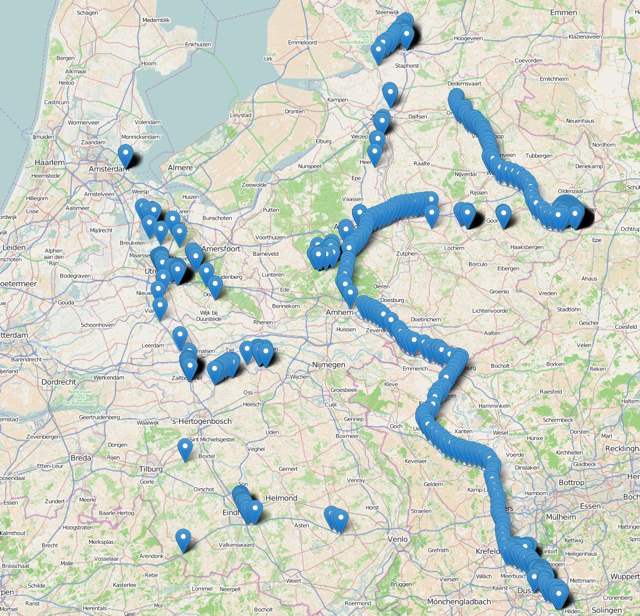
The diesel gas used by the VW cost about 1.40 € a litre and I gassed up once on pickup (the van is provided empty and you return it empty), and two other times after that, spending a total of $210 on gasoline over two weeks.
The VW California
The van itself was equipped with two beds (one in the pop-up and one made from the folding rear seat combined with a cushion on the back shelf in the “trunk”), a small fridge (good for a few days food), a two-burner gas stove, and a tiny sink. There were two folding chairs that were stored on the back door, an outside table that snapped out of the side door, and an inside table that folded out into the middle of the passenger area. The “neato” factor was relatively high.
Sleeping
We were two adults, a 13 year old and a large standard poodle traveling together. With our son Oliver needing to sleep with our dog Ethan, and Ethan not able to navigate into the pop-up, that meant that Oliver always slept down below with Ethan. The pop-up bed was, in theory, big enough to hold both Catherine and I, but in practice we ended up switching back and forth, with one of us sleeping along upstairs, the more comfortable of the two situations, and the other down below with Ethan and Oliver, every other night.
Neither up nor down was particularly “comfortable,” per se: it was a step up from, say, sleeping in a tent on the ground in a sleeping bag, but the beds were hard and the lower bed had a lot of pointy bits and bumps that made it particularly uncomfortable. With some better bedding (the DRM-rental bedding wasn’t luxurious), especially some better pillows, this might have been made a tad better, but as it was, we got between 50% and 75% of a good night’s sleep over the two weeks.
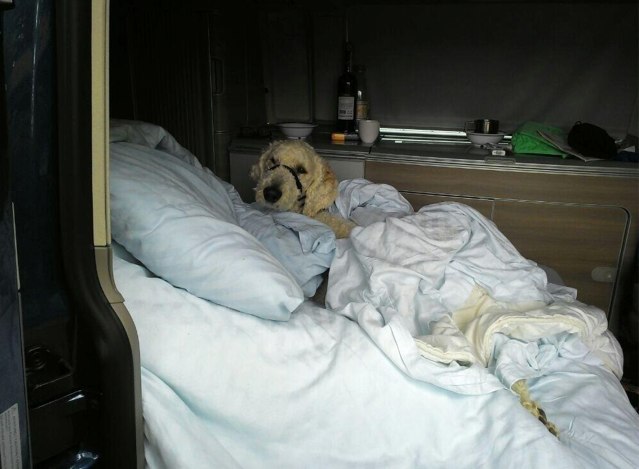
Cooking
Despite the tiny kitchen, we were able to cook most of our meals in the van. We shopped in markets, small grocery stores and from roadside stands and cooked simple meals: coffee (or hot chocolate) with cereal and yoghurt for breakfast, sometimes supplemented by fried potatoes or the like, and sometimes with pastries from the campground canteen when available; pasta or rice or salad or fish or some such for lunch and supper. The campgrounds we stayed at generally had a central dishwashing area, so we didn’t need to wash the dishes in the tiny sink (which would have been impossible in any case). We ate well, and relatively inexpensively.
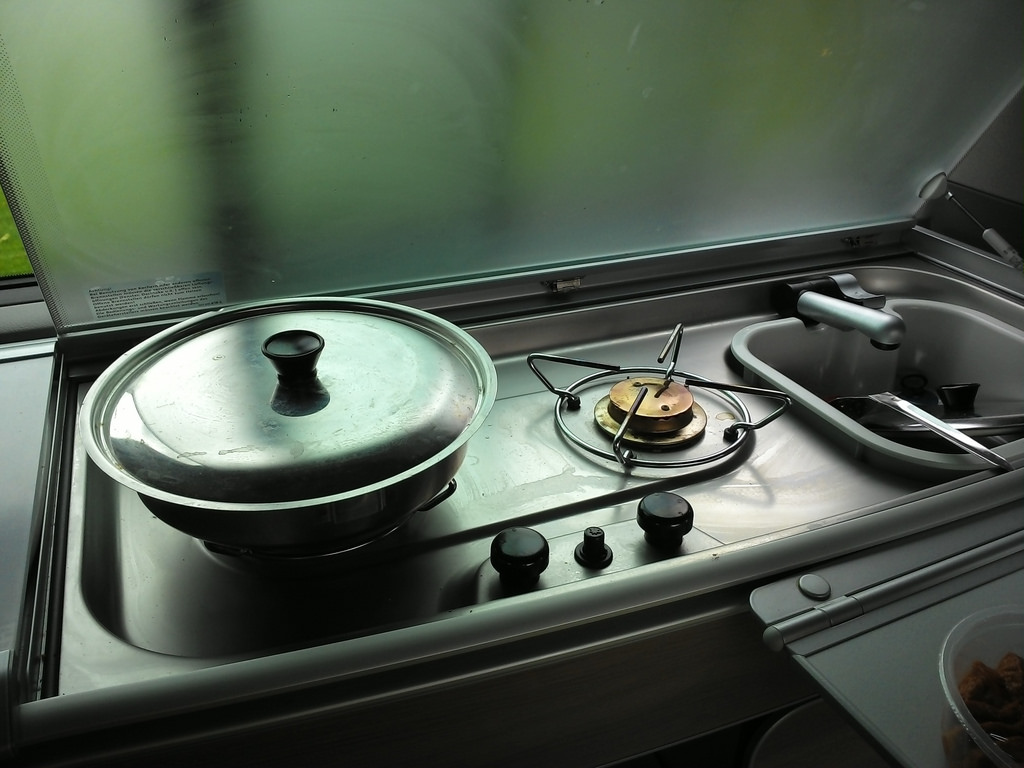
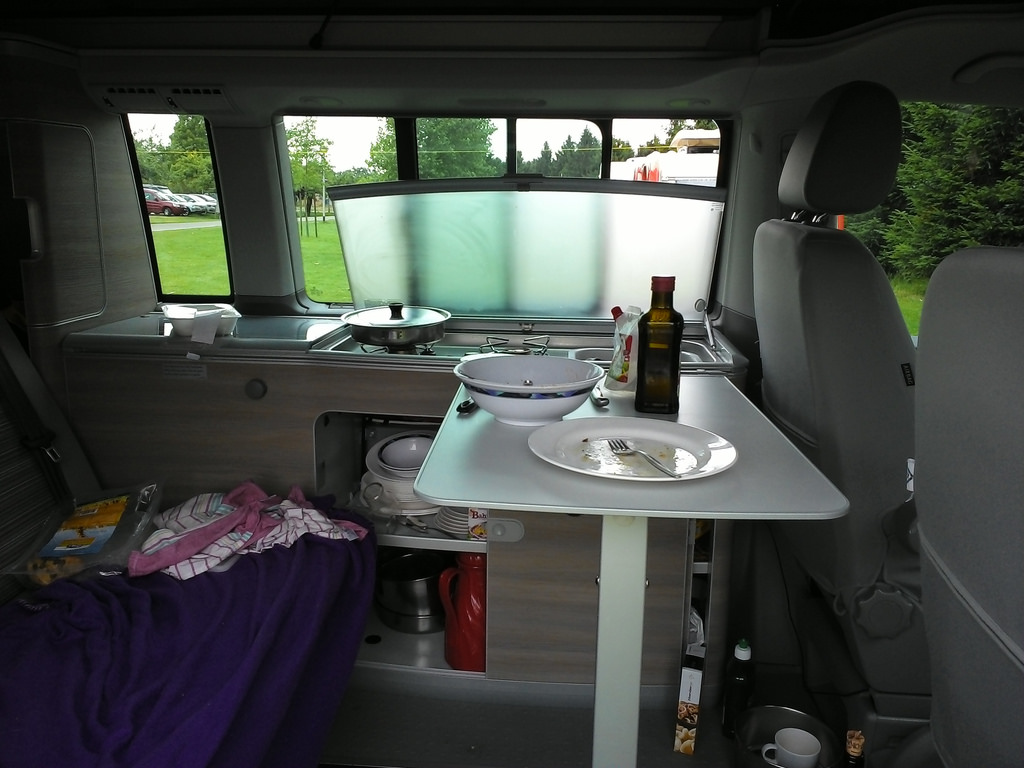
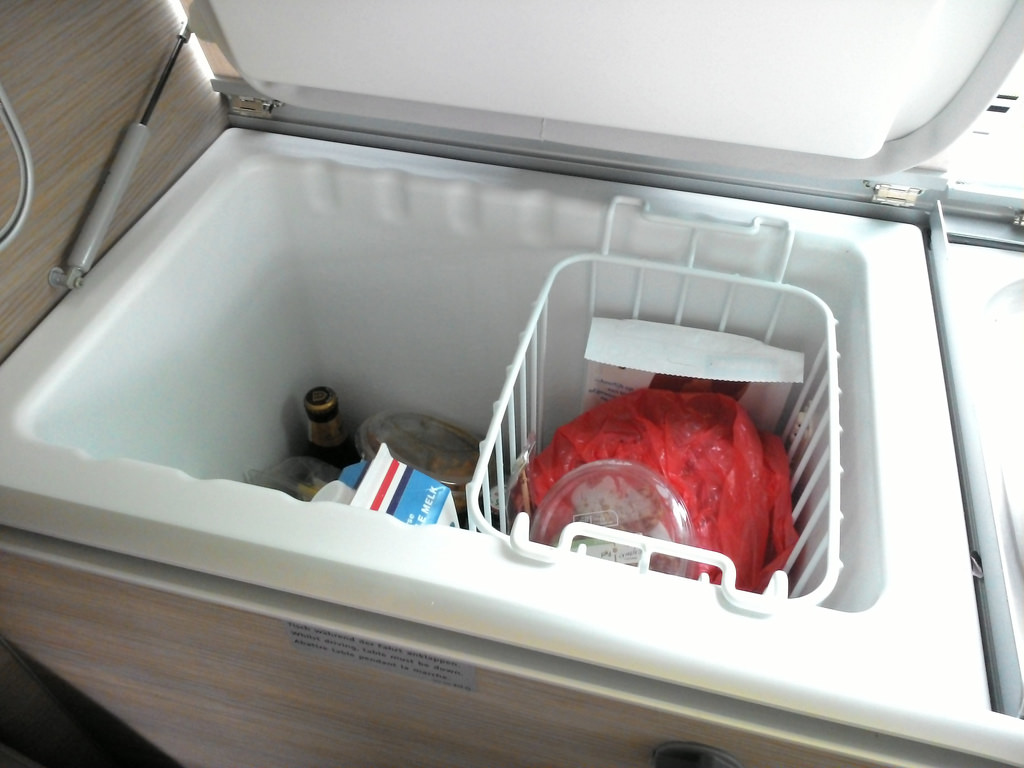
Driving
The VW California, for a house-on-wheels, is a pretty nice vehicle once it’s out on the road. It’s close enough to car-sized that the only size-related worries are remembering that it’s 2.3 m tall so can’t fit in many parking garages. The six-speed transmission was a joy to drive, and the van handled well even at 130 km/h on the autobahn.
Catherine and I sat in the bucket seats up front while were were driving, and Ethan and Oliver sat in the bench seat at the back. There was plenty of room for everyone.
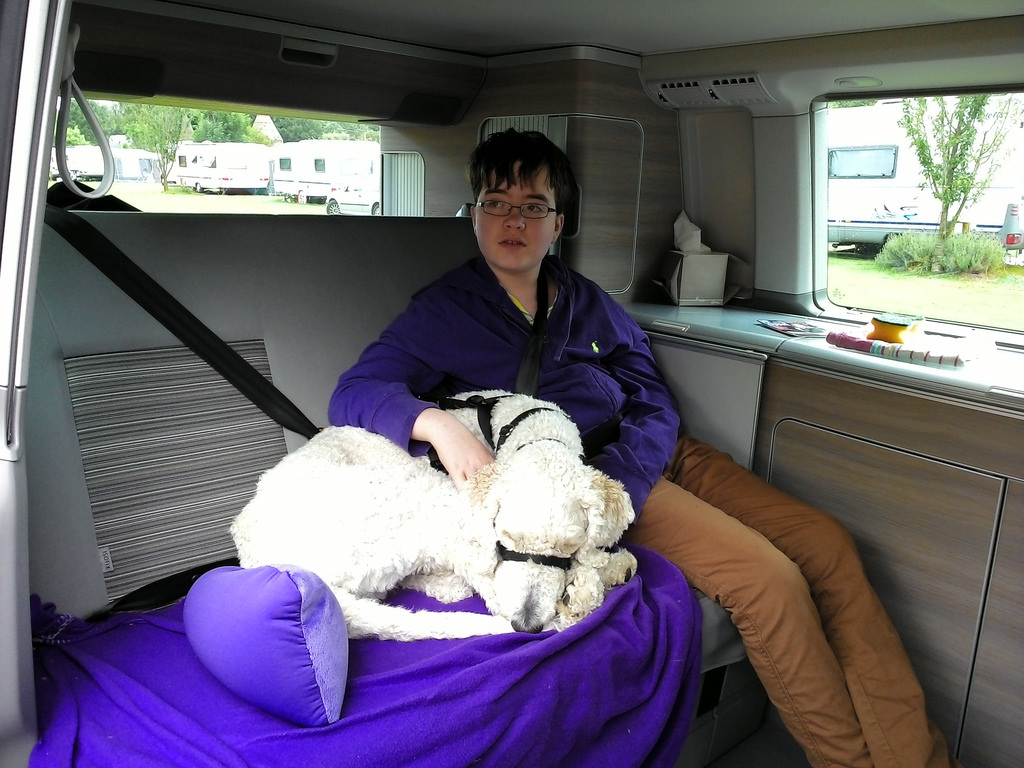
Buttons and Switches
The pop-up roof operates electrically: with the ignition running you toggle a control-panel in the top centre console to “Pop Up” and then to “Open” and hold the button until the motors raise the pop-up to its full “up” position. Taking the pop-up down is simply the reverse operation, with the added need to take care that the fabric of the pop-up tent doesn’t become snagged and that it folds inward and not outward.
The gas bottle for the stove is located at the bottom of the closet in the rear of the van: to use the stove the gas bottle valve needs to be opened and a switch under the burners in the dishes closet needs to be switched on. The burners themselves are electric-start: you turn the gas control to “on,” push down, and then click the ignition button. It took us a while to get this down, but eventually it became second nature.
All of the campsites we rented came with electricity: there’s a master electrical outlet on the back-left of the van on the outside that gets tethered, via some special-purpose cords, to the campground electric pole, which uses a special-purpose connector. All of the bits and bobs for this were included in the sliding cabinet under the bench seat. Sometimes the campground electric pole was some distance away from the campsite, but the included extension cord was always long enough to bridge the gap. The custom appears to be to simply run the extension cords from pole to camper across the dirt and grass, with no heed paid to tripping or driving-over dangers.
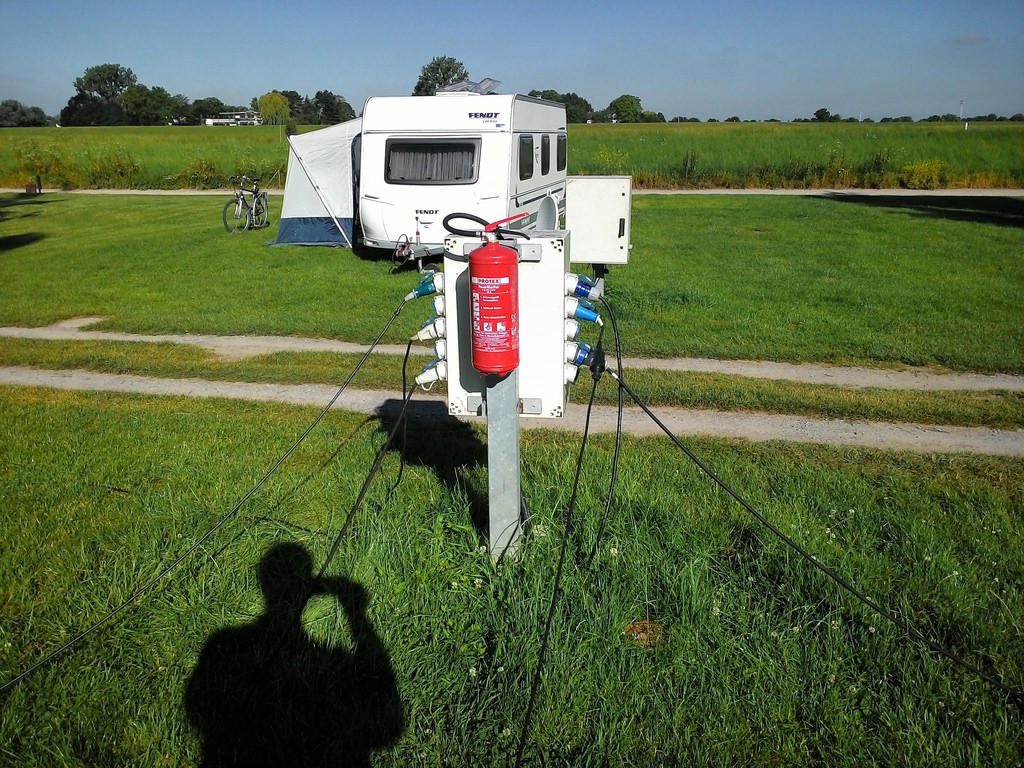
Inside the van the electricity operates the fridge, the lights, and feeds several electrical outlets (one standard European plug and a cigarette lighter plug behind the driver’s seat and a second cigarette lighter plug in the back). Confusingly, there’s a second standard European plug behond the driver’s seat that is only powered when driving, so if you are, as I was, charging a mobile device you need to switch outlets on departure or arrival.
Water to the sink comes from a water storage tank that’s filled from the inlet beside the electrical plug on the outside left rear; there’s a water-level indicator on the control panel at the front of the van and water for filling the tank up is generally easily available at campgrounds. There’s a grey water storage tank that collects water from the sink; there’s a way to empty this, but it never filled up for us, so I never had to learn how.
Campsites
We stayed in seven campsites over the 14 days:
- Rheincamping Meerbusch north of Düsseldorf was our first and last stop on the trip. It’s handy to the DRM rental station – about 30 minutes drive through the city – and is located directly on the banks of the Rhein river. The staff are friendly and English-speaking. There’s bread and pastries available for ordering in advance every morning, a decent restaurant/bar, and something of a beach on the Rhein. The toilets and showers were clean, and hot water and toilet paper were included in the price; wifi, which was flaky, was available via vouchers for purchase. There’s airplane noise from the Düsseldorf airport, which is just across the river, and river boat noise from the constant flow of boats up and down the Rhein, but neither is bad enough to suggest not staying here.
- De Twentse Es in Enschede, Netherlands, was our home four nights. We choose it simply because it was very close to our friends Ton and Elmine’s hous; as it happened, it was one of the nicest campgrounds we stayed at as an added bonus. It was clean, had a well-resourced shop, very modern toilets and showers (with hot water and toilet paper included) and swimming pool (though it was too cold for us to use during our visit). Wifi, with excellent throughput, was included in the price. The only odd thing is that the receiption desk is closed a certain periods of the day, so if you arrive or wish to depart during one of these times you can get stuck with a wait. The environment is on the edge of the city in a lovely forested area.
- Camping de Kikkerije in Meppel, Netherlands was a place we ended up at late in the day, with our GPS running low on batteries and no obvious destination in sight. Located on the side of a canal on the outskirts of town, it was a small campground with mostly seasonal campsites and a few spots avaialble for vagabonds like us. A small toilet block with pay-hot-water for the shower and sink but with toilet paper included. Wifi was available via vouchers for purchase. Friendly owners. A good, simple place to spend a night.
- Watersportcamping De Maasterp in Maasbommel, Netherlands was another late-in-the-day arrival and it was raining to boot. They had a single site available for a single night, which suited our needs. Maasbommel is very much vacation country, and De Maasterp was one of several large campgrounds in the area. Our campsite was right at the edge of the water with a beautiful view. The toilets and showers were hike up to the centre of the campground; they were clean, but you needed to bring your own toilet paper and pay for hot water for showers and sinks. Wifi was available via vouchers for purchase. There was fresh bread available every morning, and there was a (somewhat imposing-seeming) bar on site for drinks.
- De Hoge Veluwe National Park was the closest we came to “nature” camping on the trip: the campsite is located just inside the park’s Hoenderloo entrance and requires purchase of a park ticket as well as payment for the campsite pitch, so it was also the most expensive place we stayed. The campsite is very nice, though: pitches are very large and are arrayed in a circle around a meadow. The toilets and showers were in a bright, open building with a green roof that included a small lending library, and a fire pit for groups. There was wifi included in the price; showers were coin-operated and toilet paper wasn’t included. The best aspect of the campsite was that it was so close to the park: a quick 5 minute drive (or 20 minute cycle, via the fleet of free white bicycles based directly beside the campsite) was the visitor centre, restaurant, network of bicycle trails and art gallery filled with Van Gogh, Renoir, Seurat and more. It’s hard to imagine a better situation, and we really enjoyed the two nights spent here.
- Camping de Boomgaard in Bunnik, Netherlands, just outside of Utrecht, was the perfect base from which to explore the city. Its primary benefit to us was that it was 10 minutes walk from the Bunnik train station which was, in turn, a single 5 minute stop away from the central station in Utrecht. The camprground was a nice mix of seasonal and overnight campers and there was a very family-friendly feel to the place: it had a swimming hole, a petting zoo, wagon rides for kids and a trampoline. The toilets and showers were clean (coin-operated hot water; bring your own toilet paper) and we were able to do laundry and an much-needed time. The office opens late and closes early so arrival and departure need to be timed to coordinate.
- Campinastrand in Dessel, Belgium was a campground with its best years seemingly behind it. The location, on a chain of artificial fishing lakes, was idyllic, but the infrastructure was aging, and we had some issues with hot water and electricity. The staff were friendly, though and the price – 14 € for everything, including electricity – was by far the cheapest of the trip. There was no wifi that we could identify, and hot water (when it worked) was coin-operated and toilet paper was bring-your-own. The bar with terrace was a little “do we really belong here?” imposing, but we hung out anyway and had a pleasant hour or two drinking beer and playing cards.
Would we do it again?
The “house on your back” flexibility of the VW camper was certainly a nice feature of our vacation: we could stop anywhere for a hot lunch if we wanted, and we could explore the highways and back roads without fear that we’d ever be all that far from a campground. We got to see places that would have been difficult to get to without a vehicle, and we got to travel by the seat of our pants, making up the itinerary as we went along. The campgrounds themselves varied in quality, but were generally pleasant places to spend the night.
The van, while a little cramped for three plus dog, was just big enough to handle us, and I wouldn’t have wanted to drive around one of the larger more-RV-like larger options. That said, the jump from VW camper up to larger vehicles would, I imagine, significantly increase the comfort of the beds, and I can only imagine the sleeping-on-inlaws-couch feel of the VW beds becoming more problematic as Catherine and I age, so who knows.
We’ll need some time to chew on the experience before knowing whether it’s the sort of vacation we’d take again, but we all enjoyed the experience and are glad we choose to do it as we did.
 I am
I am
Comments
Fantastic and detailed
Fantastic and detailed account of what sounds like a great trip in prime campervan territory!
Did you come across any providers that rented the slightly more vintage versions of the vw camper? eg circa 1960-80 bay window...
Add new comment